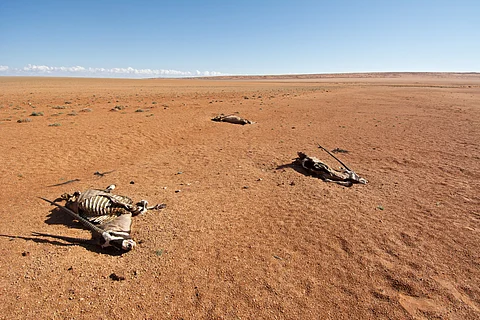

Long-lasting, persistent multi-year droughts, like the 15-year-long devastating mega-drought in Chile, have become more frequent and drier, and will continue to advance with a warming climate, warns a new 40-year study.
The global terrestrial land affected by these multi-year droughts has increased at an alarming rate of around 50,000 square kilometres per year between 1980 and 2018.
The researchers identified 13,176 multi — year droughts (MYDs) during the same four-decade period — each representing an MYD event that lasted for at least two consecutive years. The study also found that these droughts grew in size and the temperature anomalies in affected areas increased.
The study, published in Science journal on January 16, was conducted by scientists from Swiss Federal Institute for Forest, Snow and Landscape Research WSL, Switzerland, National University of Singapore, ETH Zurich, Switzerland, Institute of Science and Technology Austria, and University of Bern, Switzerland.
MYDs are events that can last till years even decades and lead to extreme soil water depletion and reduced streamflow, which, in turn, the authors say, can translate into irreversible consequences like massive crop failures, increased tree mortality, diminished ecosystem productivity and reduced water supply.
“During MYD events, prolonged water deficits can overshoot the tolerance of ecosystems, resulting in a widespread loss of productivity, browning, and even vegetation dieback,” said the study published in Science journal.
The researchers found that 10 most severe MYDs occurred on all evaluated continents except Australia, with three of them extending until 2018. A few examples were the recent MYDs in central Chile, the western United States, and Australia.
On average, the area affected increased at a rate of sq. 16,704 km/year for the top 10 MYDs and a rate of 49,279 sq. km/year for the top 500 MYDs, with the most affected ecosystems being temperate grasslands.
“Yet, beyond such well-described examples, similar events may have occurred but stayed below the radar owing to comparably fewer perceived consequences and thus limited scientific focus,” the study said.
Five of the top 10 MYDs occurred from 2007 to 2018, with the eastern Congo basin experiencing the longest-lasting (2010 until 2018) MYD, covering an area of 1,494,226 km2.
The MYD that occurred in the southwestern Amazon lasted nine years, and the area affected peaked in 2015, whereas before 2015, the annual coverage gradually increased from 112,540 km2 in 2010 to 212,925 km2 in 2014, which is nearly equivalent to the size of the United Kingdom.
The MYDs in central Africa and the southwestern Amazon lasted until 2018, when they affected areas of 287,878 km2 and 139,799 km2, respectively.
The findings also suggested that the years with the largest areas affected by MYDs followed El Niño events in 1998, 2010, and 2015, which indicated that the fingerprints of El Niño events on prolonged droughts extend beyond the tropics.
Warning that such long-lasting droughts may become more common in the 21st century in terms of its severity, trend, and impact, the authors said that their analysis provided an important benchmark for facilitating more effective and collaborative preparedness toward mitigation of and adaptation to such extreme events.